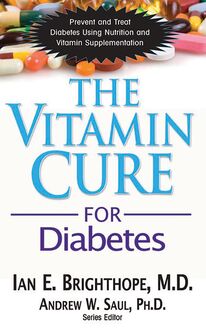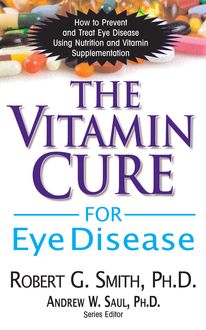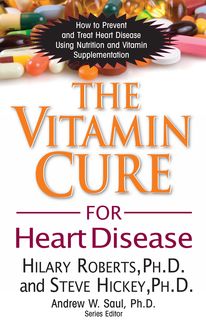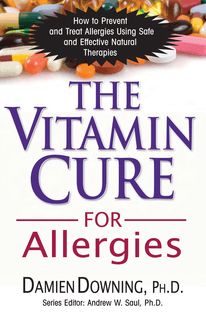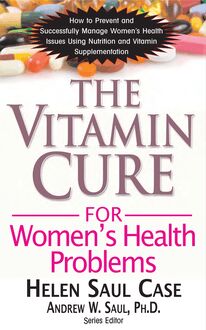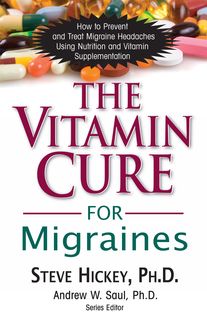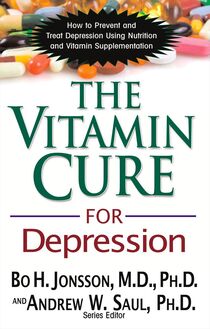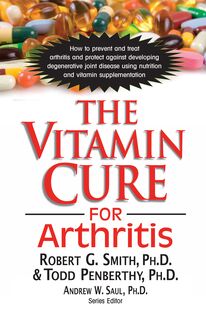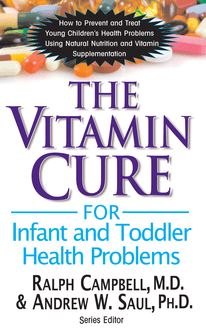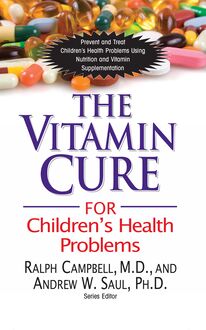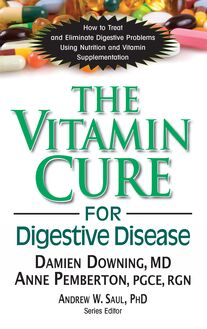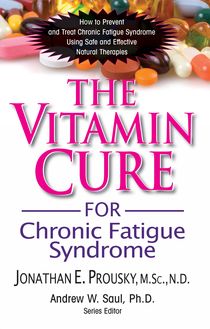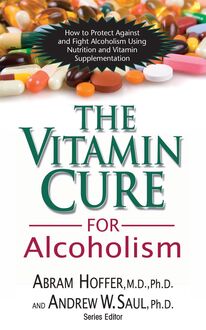The Vitamin Cure for Alcoholism , livre ebook
88
pages
English
Ebooks
2009
Vous pourrez modifier la taille du texte de cet ouvrage
Obtenez un accès à la bibliothèque pour le consulter en ligne En savoir plus
Découvre YouScribe en t'inscrivant gratuitement
Découvre YouScribe en t'inscrivant gratuitement
88
pages
English
Ebooks
2009
Vous pourrez modifier la taille du texte de cet ouvrage
Obtenez un accès à la bibliothèque pour le consulter en ligne En savoir plus
Publié par
Date de parution
01 mai 2009
Nombre de lectures
2
EAN13
9781591205135
Langue
English
Poids de l'ouvrage
1 Mo
Publié par
Date de parution
01 mai 2009
Nombre de lectures
2
EAN13
9781591205135
Langue
English
Poids de l'ouvrage
1 Mo
T HE V ITAMIN C URE
for Alcoholism
Orthomolecular Treatment of Addictions
A BRAM H OFFER , MD , P H D AND A NDREW W. S AUL , P H D
The information contained in this book is based upon the research and personal and professional experiences of the authors. It is not intended as a substitute for consulting with your physician or other healthcare provider. Any attempt to diagnose and treat an illness should be done under the direction of a healthcare professional.
The publisher does not advocate the use of any particular healthcare protocol but believes the information in this book should be available to the public. The publisher and authors are not responsible for any adverse effects or consequences resulting from the use of the suggestions, preparations, or procedures discussed in this book. Should the reader have any questions concerning the appropriateness of any procedures or preparation mentioned, the authors and the publisher strongly suggest consulting a professional healthcare advisor.
Basic Health Publications, Inc. 28812 Top of the World Drive Laguna Beach, CA 92651 949-715-7327 • www.basichealthpub.com
Library of Congress Cataloging-in-Publication Data
Hoffer, Abram
The vitamin cure for alcoholism : orthomolecular treatment of addictions / Abram Hoffer and Andrew W. Saul.
p. cm.
Includes bibliographical references and index. ISBN 978-1-59120-513-5
1. Alcoholism. 2. Alcoholism—Treatment. 3. Orthomolecular therapy. I. Saul, Andrew W. II. Title.
RC565.H624 2009 362.292—dc22
2008054330
Copyright © 2009 Abram Hoffer and Andrew W. Saul
All rights reserved. No part of this publication may be reproduced, stored in a retrieval system, or transmitted, in any form or by any means, electronic, mechanical, photocopying, recording, or otherwise, without the prior written consent of the copyright owner.
Editor: John Anderson Typesetting/Book design: Gary A. Rosenberg Cover design: Mike Stromberg
Printed in the United States of America
10 9 8 7 6 5 4 3 2 1
C ONTENTS
Acknowledgments
Foreword by Donald R. Davis, Ph.D.
CHAPTER 1: Nutritional Factors for Alcoholism
CHAPTER 2: What Causes Addictions?
CHAPTER 3: Niacin for Alcoholism: How It All Began
CHAPTER 4: Conquering Alcoholism Nutritionally
CHAPTER 5: Results of Vitamin Treatment
CHAPTER 6: The Controversy Over Psychedelic Therapy
CHAPTER 7: Stopping Tobacco Smoking and Caffeine Use
CHAPTER 8: Orthomolecular Support During Withdrawal and Drug Overdose
CONCLUSION: The Way Out
APPENDIX: Finding Reliable Information on Orthomolecular Medicine
Recommended Reading and Bibliography
References
About the Authors
A CKNOWLEDGMENTS
To Bill W., cofounder of Alcoholics Anonymous (AA), and to the three physicians—David Hawkins, Ed Boyle, and Russell Smith— who confirmed Bill’s conclusion that alcoholics need to become well, and not merely abstinent. Bill was a seer with a vision and was therefore able to act in spite of negative pressure. Most of AA thought that vitamin therapy was none of his business, nor theirs. Bill W. knew that it was his business to help all alcoholics and other addicts not only be free of their addiction but to be comfortable with their new state of well-being and freedom.
—Abram Hoffer
I add my thanks to all the physicians and researchers who, in the face of medical opposition, have so ably demonstrated that high-dose vitamin therapy works. Some day soon, healthcare without megavitamin therapy will be seen as we today see childbirth without sanitation, or surgery without anesthetic. I dedicate this book to Colleen, who, in seeing that so clearly, helps me stay the course.
—Andrew W. Saul
F OREWORD
T he prevalence of alcoholism reflects a fundamental ignorance or carelessness about nutrition, because the development of alcoholism generally requires years of heavy drinking. Prolonged consumption of large amounts of calories from alcoholic beverages, and other nonwhole foods such as refined sugar, is simply inconsistent with the rules of good nutrition, even if alcoholism and other addictions did not exist.
But they do. Therefore, this book can be a godsend for many persons—for those who suffer from alcohol addiction, for their friends and loved ones, and for those in the relevant helping professions. Its central message is that alcoholism is primarily a metabolic disease that should be treated with due consideration of its physiological roots. The old moralistic approach and the more recent behavioral and psychological treatment approaches have a dismal record of failure, largely because they pay little or no attention to the crucial physiological and nutritional needs of alcoholics.
The keys to more appropriate and effective approaches come from studies and from metabolic tests showing that alcoholism is a complex genetic-biochemical disorder more closely related to diabetes or to sugar metabolic syndrome than to any behavioral or psychological disorder. Although scientists widely agree that susceptibility to alcoholism is inherited (by roughly 10 percent of the population), treatment and support programs generally ignore this fact and its physiological implications. Likewise, malnutrition is well-known to physicians treating alcoholics, but they nearly always assume that malnutrition is a simple, predictable consequence of heavy drinking, not a complex, contributing cause of alcohol addiction. Nutrition is certainly not seen as the effective treatment it is.
My late mentor at the University of Texas, Roger J. Williams, devoted three books and over two dozen scientific articles to the problem of alcoholism. His work was remarkably advanced and insightful. Nearly fifty years ago, in his second book on alcoholism, Alcoholism: The Nutritional Approach , he summarized part of his work in animals: “Our first important finding is that [laboratory] rats exhibit a high degree of individuality in their behavior when they are all fed alike and treated alike in every way. . . . Our second finding is that this individuality in drinking behavior … is genetically determined…. A third finding [is that] what the rats have to eat, that is, the chemical composition of their food, is a potent factor in determining how great is their physiological urge to drink alcohol.” Another of my senior colleagues at the University of Texas, William Shive, reported in 1955 that the amino acid L-glutamine protects bacterial cells from the toxic effects of alcohol. Dr. Williams and his coworkers soon found that poorly nourished rats decreased their voluntary consumption of alcohol by about 40 percent, on average, when L-glutamine was added to their diets. Later, they also found evidence that it is highly effective for some humans in reducing their appetite for alcohol.
Abram Hoffer and Andrew Saul have found that Dr. Williams’s observations apply well to humans: vitamins and other nutritional factors play a potent role in countering the compulsion to drink. No treatment and no amount of social support is likely to achieve long-term abstinence without addressing these underlying biochemical issues.
Over the years, a few other researchers, practitioners, and laypersons have advocated similar ideas about alcohol and some other addictions. Unfortunately, these advocates have not yet found a sufficient audience to achieve a wide impact. There are several contributing reasons why this is so. Pharmaceutical companies have no financial incentive to research natural, unpatentable approaches to addiction. More fundamentally, such low-technology approaches have never become fashionable among medical researchers. Remarkably, the American Psychiatric Association and physicians in general recognize their limited ability to deal adequately with alcoholism by referring sufferers to a lay support organization, Alcoholics Anonymous (AA). Unfortunately, AA has limited itself by sidestepping nutrition. It didn’t have to happen this way, as Drs. Hoffer and Saul explain. The cofounder of AA, Bill W., was treated by Dr. Hoffer in 1958 and into the 1960s. Bill found great benefit from a nutritional approach, repeated his success among many of his friends and associates, and despite great efforts, he was unable to influence the organization toward broadening its approach.
Human nature can be disheartening at times, especially in the face of such devastating problems as alcohol and drug addictions. The good news for readers of this book is that it offers “new” approaches and hope that you are unlikely to learn about elsewhere. When will the medical and other helping professions give serious consideration to these insights from genetics, human physiology, animal studies, the cofounder of AA, and a few pioneering researchers and physicians? I hope this book will hasten that time, by bringing relief and renewed health to legions of sufferers and also by nurturing so many successful advocates for advancement that their voices will finally become irresistible.
—Donald R. Davis, Ph.D. Austin, Texas
CHAPTER 1
N UTRITIONAL F ACTORS FOR A LCOHOLISM
E dith had been drinking up to 40 ounces of whiskey daily for three weeks. Her gait was unsteady, her speech was limited to a few words, she trembled and complained of jitters. She was admitted to the hospital and immediately given 400 milligrams of niacin intravenously, plus 3,000 mg of niacin and 2,000 mg of vitamin C by mouth. Within minutes, she had calmed down. The second day, she was given niacin (3,000 mg) and vitamin C (2,000 mg) after each meal. On the second morning she was still jittery, but by that afternoon she was well and remained so for the rest of her hospital stay.
Fred had been drinking for sixteen years and suffered three bouts of delirium tremens (DTs) with hallucinations. He was irritable and tense. He was given 2,000 mg of niacin and 2,000 mg of vitamin C after each of three meals. The same day, by 10:30 P.M. , he was cooperative, pleasant, and related normally
